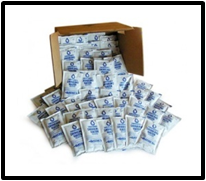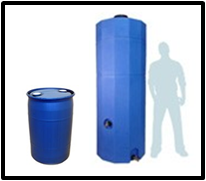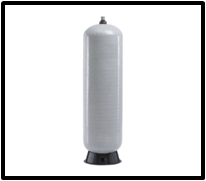Because you may not have access to another water supply during a disaster.
We recommend emergency water storage in the order listed below. Recommendations on this page are largely from one very good company because this company carries such a complete collection of water storage and other products. [All the containers featured here are made from 100% non-toxic food-grade material that is completely BPA free.]
Packaged Containers
 These are perfect for packing in 72 hour emergency kits or bug-out-bags or just grabbing and tossing into an automobile. Another advantage is the long shelf life they provide. If these containers remain factory sealed, they can preserve water for five years. This means you can simply store them and forget about recycling the water every six months.
These are perfect for packing in 72 hour emergency kits or bug-out-bags or just grabbing and tossing into an automobile. Another advantage is the long shelf life they provide. If these containers remain factory sealed, they can preserve water for five years. This means you can simply store them and forget about recycling the water every six months.
The big caveat with this approach is it is very pricey water. The advantage is you are getting a practical and secure purchase.
Reusable Containers
 We believe small and reusable containers are a great and affordable way to start building a water supply. An important advantage to this approach is they are grab-and-go portable. Their comfortable handle and smaller size makes them easy to carry. The 3.5 gallon size also makes them easy to store in small places.
We believe small and reusable containers are a great and affordable way to start building a water supply. An important advantage to this approach is they are grab-and-go portable. Their comfortable handle and smaller size makes them easy to carry. The 3.5 gallon size also makes them easy to store in small places.
They are not only stackable, but they interlock and are cross stackable up to four feet high. They can also be used for food storage for such foods and legumes, grains and packaged foods.
Drums and Tanks
 The next option up is plastic drums or reserve tanks that range from 15 gallons to 250 gallons or more. This illustration represents water barrels from 30-55 gallons. And it shows a 250 gallon container which holds almost as much as five 55-gallon barrels, but takes up the floor space of only one. The tanks can be a good way to insure an adequate emergency water supply for up to a number of weeks.
The next option up is plastic drums or reserve tanks that range from 15 gallons to 250 gallons or more. This illustration represents water barrels from 30-55 gallons. And it shows a 250 gallon container which holds almost as much as five 55-gallon barrels, but takes up the floor space of only one. The tanks can be a good way to insure an adequate emergency water supply for up to a number of weeks.
Cycled Water Tank
 There is a patented design water tank that automatically recycles itself as you use the everyday water in your house. It’s like a second water heater, except it’s not a heater. It’s a water tank. It installs in-line with your incoming water supply.
There is a patented design water tank that automatically recycles itself as you use the everyday water in your house. It’s like a second water heater, except it’s not a heater. It’s a water tank. It installs in-line with your incoming water supply.
You might not like the idea of draining and refilling many gallons of water every six months. With this model, you can install it and forget about it. Also, these tanks come with a backup pump so should the main water supply power go out, you will still have pressurized water to run throughout your home.



